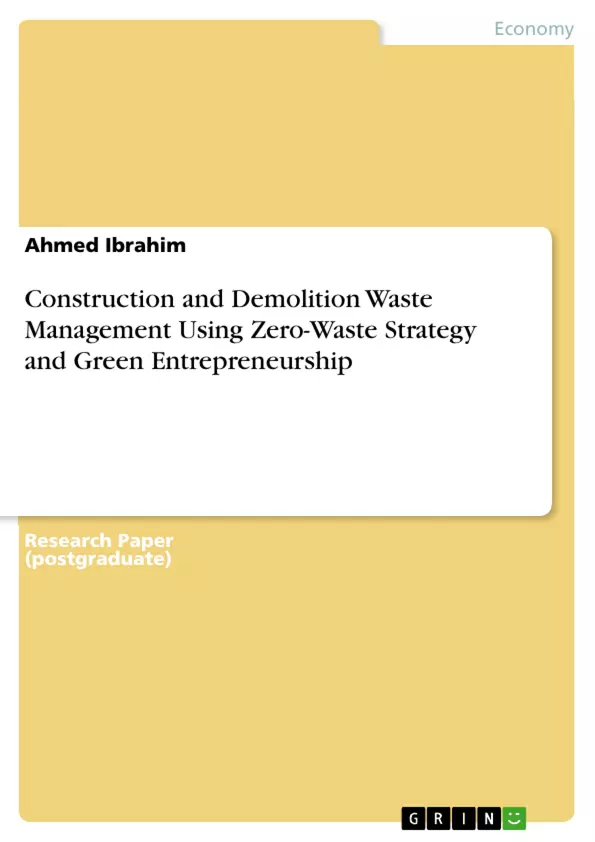Sustainable development is considered to be the main solution for various environmental problems facing the world nowadays. In this project, we are going to discuss the definition and importance of sustainability. Moreover, this Project States the condition of C&D (construction and demolition) wastes in Egypt, and their handling. It also explains the concepts of zero waste and green entrepreneurship, and connects these concepts through a variety of integrated case studies. Therefore, we can define a solution to the C&D waste problem in Egypt.
The vision of the report that C&D wastes is one from the largest and most hazard wastes in Egypt and up to now Egypt does not appreciate the economic value in these wastes and does not realize their environmental impacts on the people health nor their social impacts on the free lands which are used to be dump sites for these wastes. The report show five case studies aim to reach 100% recycling or zero waste and build green entrepreneurship for C&D waste. This connection between zero waste and build green entrepreneurship will produce comprehensive solution for C&D waste in Egypt to solve the different aspects of this problem and get great economic benefit through this solution.
Table of Contents
- Introduction and Objective:
- Construction and Demolition Wastes:
- Statistics for Construction Wastes:
- Statistics for Demolition Wastes:
- Construction and Demolition Projects Impacts on the Community:
- Wastes in Egypt:
- Levels of Wastes in Egypt:
- Handling of C&D Wastes in Egypt:
- Zero Waste Management for C&D Wastes:
- Green Economy and Entrepreneurship:
- Case Studies:
- Victoria State Case Study:
- Building Sector in Greece:
- Kuwait Case Study:
- Turkey Case Study:
- Rebuilding C&D Waste Recycling Efforts in India.
- Reflections and Recommendations:
Objectives and Key Themes
This project examines the issue of construction and demolition (C&D) waste management in Egypt, advocating for a sustainable approach through the application of zero-waste strategies and green entrepreneurship. It analyzes the current state of C&D waste management in Egypt, highlighting the challenges and opportunities associated with its handling and disposal.
- The environmental impact of C&D waste and its economic implications.
- The implementation of zero-waste strategies for effective C&D waste management.
- The potential of green entrepreneurship in driving sustainable C&D waste solutions.
- Case studies illustrating successful C&D waste management initiatives worldwide.
- Recommendations for improving C&D waste management practices in Egypt.
Chapter Summaries
The project delves into the issue of C&D waste management in Egypt, outlining the current state of waste generation, handling, and disposal. It examines the impact of C&D waste on the environment and local communities, while exploring the potential of zero-waste strategies and green entrepreneurship as solutions.
- The introduction sets the context for the project, discussing the importance of sustainable development and the environmental challenges posed by C&D waste.
- Chapter II provides statistics and data related to C&D waste generation in Egypt, highlighting the extent of the problem and the need for effective management strategies.
- Chapter III explores the impact of C&D projects on local communities, addressing potential environmental and social consequences.
- Chapter IV delves deeper into the current state of waste management in Egypt, examining the handling and disposal of C&D waste within the country.
- Chapter V introduces the concept of zero-waste management for C&D waste, exploring its principles and potential benefits.
- Chapter VI discusses the role of green economy and entrepreneurship in promoting sustainable C&D waste management, highlighting the economic potential of these approaches.
- Chapter VII presents a collection of case studies from various countries, showcasing successful examples of C&D waste recycling and management initiatives.
Keywords
The project focuses on C&D waste management in Egypt, exploring sustainable solutions through zero-waste strategies and green entrepreneurship. Key keywords include: construction and demolition waste, sustainability, zero-waste, green entrepreneurship, environmental impact, waste management, recycling, case studies, and Egypt.
- Quote paper
- Ahmed Ibrahim (Author), 2015, Construction and Demolition Waste Management Using Zero-Waste Strategy and Green Entrepreneurship, Munich, GRIN Verlag, https://www.grin.com/document/1139827



